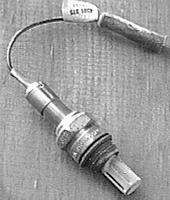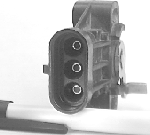AutoTips Sensor Page:
The computers on most modern cars
take inputs from a number of sensors and use that information to calculate
fuel injection, timing, transmission operation, and a number of other actions.
Not all cars will have all sensors. Here are a few typical sensors and
what they do. Computers in modern cars will have a range for expected readings
for the sensors, if one falls out of the expected range, the computer can
store an error code. Sometimes, this will also trigger a SERVICE ENGINE
or similar light. A mechanic can read these codes, or on some
cars you can do it yourself. See the book "Sure You Can" from
Wells Mfg. Corp, an excellent
book (under $5) to carry in the glove compartment of your GM, Ford, or
Chrysler product.
MAF Sensors or Airflow meters measure
airflow into the engine. Click on the images of the engines on the Underhood
page to see mass airflow sensors on the engines.
MAP Sensor (Manifold
Absolute Pressure) Measures the air pressure in the intake manifold. Changes
in engine operation and speed will affect the MAP sensor reading, which
the computer uses in fuel and timing calculations. Often it will have a
single vacuum line connection plus an electrical connection. Some
turbo charged cars also use the MAP sensor to measure barometric pressure.

Knock Sensor
or sometimes called a Ping Sensor - Listens for engine knock and
the computer adjusts timing and fuel to compensate. Fuel, temperature,
engine load, and engine age are some of the things that affect ping.
MAT (Manifold
Absolute Temperature) Sensor Measures the air temperature entering
the engine. These are typically located in the air stream, as in the air
cleaner housing, or the intake manifold.
 Temp.
sensor
Temp.
sensor
Oxygen Sensor:
Sometimes called O2 sensor, measures oxygen in the exhaust of the engine.
The computer uses it to adjust the fuel mixture delivered to the engine.
They normally do not have any output until the temperature of the sensor
is heated by the exhaust to about 600 degrees F. A typical output voltage
runs from a few tenths of a volt to 1 volt, depending on how lean or rich
the exhaust is. When they fail, symptoms can include rough idle, poor milage,
dying at stop signs, and poor performance.
 O2
Sensor is located in the exhaust manifold.
O2
Sensor is located in the exhaust manifold.
TPS (Throttle
Position Sensor) Measures the position of the accelerator pedal. Typically
mounted on the throttle body on the engine. The computer may use both the
absolute position (how far the pedal is pressed down) and rate of change
(how fast you press on the pedal) to use in fuel and timing calculations.


Temperature Sensors - Coolant and air
temperature sensors measure engine coolant temperature, used to by the
computer in timing and fuel calculations, and on some cars the coolant
sensor is also used by the computer to turn on or off the radiator fan. Some
vehicles have a separate sensor to control the radiator fan. Failure
of either sensor can cause rough running, rough idle, poor milage.
Speed Sensor - Measures vehicle speed and / or distance for the
computer.
Return
to AutoTips home page
Return
to the AutoTips Underhood Page
Copyright AutoTips

 Temp.
sensor
Temp.
sensor O2
Sensor is located in the exhaust manifold.
O2
Sensor is located in the exhaust manifold. 